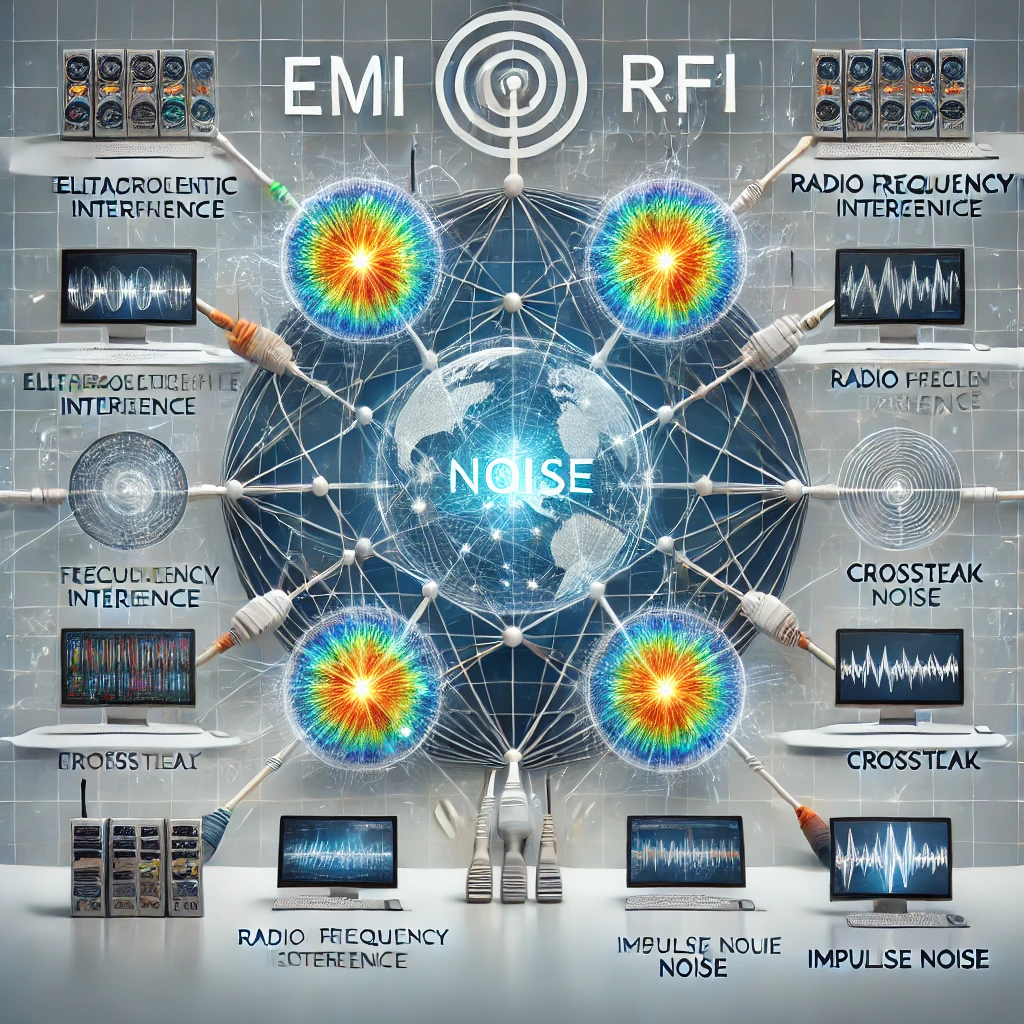When managing and troubleshooting a computer network, understanding the various types of “noise” is essential. In the context of networking, noise refers to any unwanted interference that disrupts the proper transmission of data. This article will explore the common types of noise on a computer network, their causes, and how they can be mitigated to ensure smooth network performance.
What is Network Noise?
Network noise is any form of interference that affects data transmission across a computer network. It can manifest in various forms and impact the network’s efficiency and reliability. High levels of noise can result in data loss, reduced speed, and increased latency, making it crucial for network administrators to identify and address these issues.
Types of Noise in Computer Networks
- Electromagnetic Interference (EMI) Electromagnetic interference occurs when electromagnetic signals from external sources interfere with the data signals in a network cable. Common sources of EMI include power lines, motors, fluorescent lights, and even other electronic devices. EMI can disrupt data transmission, leading to packet loss and reduced network performance.
- Radio Frequency Interference (RFI) Similar to EMI, radio frequency interference is caused by radio signals from external sources, such as cordless phones, microwaves, or wireless devices. RFI can be particularly problematic in wireless networks, where overlapping frequencies can cause significant disruptions in data transmission.
- Crosstalk Crosstalk happens when signals in one cable or circuit interfere with those in another. This type of noise is common in twisted pair cables, where the wires are closely bundled together. Crosstalk can cause data corruption and errors, especially in high-speed networks.
- Impulse Noise Impulse noise is a sudden burst of electrical energy, often caused by external sources like lightning, power surges, or faulty equipment. This type of noise can cause severe disruptions in data transmission, leading to significant packet loss and network downtime.
- Thermal Noise Thermal noise, also known as Johnson-Nyquist noise, is caused by the random motion of electrons in a conductor due to temperature. This type of noise is always present and increases with temperature. While usually minimal, thermal noise can become significant in very high-speed networks or in environments with high temperatures.
- White Noise White noise is a type of noise that contains all frequencies at equal intensity. It is typically random and can originate from various sources, including electronic components within network devices. White noise can cause a general degradation of signal quality, leading to slower data transfer rates.
- Intermodulation Noise Intermodulation noise occurs when signals at different frequencies mix together, creating new frequencies that were not originally present. This type of noise is often caused by nonlinearities in the network hardware, such as amplifiers or mixers. Intermodulation noise can create spurious signals that interfere with legitimate data transmission.
Causes of Network Noise
Several factors contribute to noise in a computer network, including:
- Poor Cable Quality: Low-quality or damaged cables can be more susceptible to external interference.
- Improper Shielding: Insufficient shielding in cables can allow external electromagnetic or radio frequency interference to penetrate the cable.
- Environmental Factors: Proximity to power lines, industrial equipment, or other sources of EMI and RFI can introduce noise.
- Faulty Hardware: Defective network devices, such as routers or switches, can generate noise.
- High Temperatures: Elevated temperatures can increase thermal noise in network components.
Mitigating Noise in Computer Networks
To minimize noise and its effects on a computer network, consider the following strategies:
- Use Shielded Cables:
- Opt for shielded twisted pair (STP) or coaxial cables to reduce susceptibility to EMI and RFI.
- Proper Cable Management:
- Keep network cables away from potential sources of interference, such as power lines or large electrical devices.
- Upgrade Hardware:
- Replace aging or faulty network hardware that may be contributing to noise.
- Regular Maintenance:
- Perform regular maintenance checks on network components to ensure they are operating correctly and within the recommended temperature range.
- Implement Noise Filtering:
- Use noise filters or suppressors to reduce the impact of external interference on the network.
- Optimize Network Layout:
- Design your network layout to minimize crosstalk by ensuring adequate spacing between cables.
The Impact of Noise on Network Performance
Ignoring noise in a computer network can have serious consequences, including:
- Data Corruption: Noise can cause errors in data transmission, leading to corrupted files or incomplete data.
- Reduced Speed: High levels of noise can slow down data transfer rates, resulting in a laggy network experience.
- Increased Latency: Network noise can increase the time it takes for data to travel from the source to the destination, causing delays in communication.
- Higher Costs: Frequent troubleshooting and the need for replacement equipment can drive up operational costs.
Conclusion
Understanding the common types of noise on a computer network is essential for maintaining optimal network performance. By identifying the sources and implementing appropriate mitigation strategies, network administrators can reduce the impact of noise, ensuring reliable and efficient data transmission.
For businesses and individuals who rely heavily on their network infrastructure, investing in high-quality cables, proper shielding, and regular maintenance is key to avoiding the pitfalls associated with network noise.









